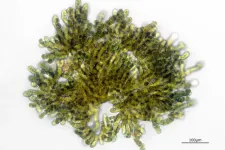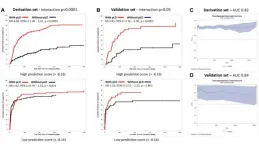(Press-News.org) Deep inside our cells—each one complete with an identical set of genes—a molecular machine known as PRC2 plays a critical role in determining which cells become heart cells, versus brain or muscle or skin cells.
When the machine is missing or broken, normal fetal development can’t occur. If it’s mutated, cells can grow uncontrollably, and cancer can arise—a fact that has made PRC2 a source of keen interest for drug developers.
New research by scientists at CU Boulder and Harvard Medical School offers an unprecedented look at how PRC2, or polycomb repressive complex 2, does its job and, specifically, how ribonucleic acid (RNA) helps it switch genes on and off.
The findings, published Sept. 22 in the journal Science, shed new light on how development occurs and could pave the way for novel therapeutics for hard-to-treat cancers, including blood, pancreatic and colon cancer, leukemia and pediatric tumors.
“We know PRC2 is extremely important for development and for maintaining the identity of cells, and we know that RNA regulates it. But mechanistically, we didn’t know how,” said co-senior author Vignesh Kasinath, assistant professor of biochemistry at CU Boulder.
For the study, Kasinath’s lab collaborated with Nobel Laureate Thomas Cech and colleagues at the BioFrontiers Institute to photograph PRC2 in action, using state-of-the-art “cryo-electron microscopy.” The technique involves freezing samples to extremely cold temperatures to preserve their native structure and then hitting them with an electron beam at speeds nearly the speed of light to create ultra-high-resolution 3D images.
Previous research has shown that this enzyme complex, made of multiple proteins, is a potent gene-silencer, effectively shutting off access to specific regions of the genome so a stem cell can differentiate into a particular cell type. In a budding heart cell, for instance, it plays a role in silencing genes that might guide it to become a kidney or liver cell.
How that happens remained a mystery.
“If you think of PRC2 as a car, we know a lot about what happens when it gets to its destination, but we don’t know how to drive it there,” said first author Jiarui Song, a Jane Coffin Childs postdoctoral fellow in the Cech Lab.
Catching development in a freezeframe
To find out, the team synthesized PRC2 and RNA in the lab and used CU’s cutting-edge Titan Krios Electron Microscopy Facility, which enables researchers to image molecules at the atomic level, to take the first-ever picture of PRC2 and RNA bound together.
They discovered that when one RNA molecule grabs on to two PRC2 proteins it clamps them down like a clamshell with RNA as the hinge, essentially gluing together their surfaces so they can’t interact with DNA. In doing so, RNA effectively silences the silencer, enabling genes in certain regions of the genome to keep firing while others remain “off.”
“RNA essentially acts as a checkpoint, making sure PRC2 only acts on certain regions of the genome,” said Kasinath.
Using biochemistry and additional experiments in zebrafish, the research team was able to confirm what they saw under the microscope in living cells.
The study is the first to define, at the molecular level, how RNA regulates PRC2 activity and could pave the way for more effective, targeted treatments for diseases where PRC2 regulation is defective.
“Understanding this mechanism could enable the development of a new generation of RNA-based therapeutics. This work lays that foundation,” said Kasinath.
Other co-authors include Anne Gooding, Wayne Hemphill and Liqi Yao of CU Boulder and Brittney Love, Anne Robertson, Leonard Zon and Trista North of Harvard Medical School.
END
How silencing a gene-silencer could lead to new cancer drugs
2023-09-27
ELSE PRESS RELEASES FROM THIS DATE:
A novel role discovered for vagus nerve
2023-09-27
The vagus nerve, known for its role in ‘resting and digesting’, has now been found to have an important role in exercise, helping the heart pump blood, which delivers oxygen around the body.
Currently, exercise science holds that the ‘fight or flight’ (sympathetic) nervous system is active during exercise, helping the heart beat harder, and the ‘rest and digest’ (parasympathetic) nervous system is lowered or inactive. However, University of Auckland physiology Associate Professor Rohit Ramchandra says that this current understanding is based on indirect estimates and a number of assumptions their new study has ...
THE LANCET: Gender inequalities worsen women’s access to cancer prevention, detection and care; experts call for transformative feminist approach
2023-09-27
Peer reviewed / Review, analysis and opinion
Cancer is a leading cause of mortality in women and ranks in the top three causes of premature death (under age 70) in women in almost every country worldwide.
New analysis finds, of the 2.3 million women who die prematurely from cancer each year, 1.5 million lives could be saved through the elimination of exposures to key risk factors or via early detection and diagnosis, while a further 800 000 deaths could be prevented if all women could access optimal ...
Prolonged mismatch between calories eaten and burned may be putting many athletes at risk of REDs (Relative Energy Deficiency in Sport)
2023-09-27
The estimated prevalence of REDs varies by sport, ranging from 15% to 80%. The syndrome often goes unrecognised by athletes themselves, their coaches, and team clinicians, and may unwittingly be exacerbated by the ‘sports culture,’ because of the perceived short term gains on performance from intentionally or unintentionally limiting calorie intake, warns the Statement.
REDs was first recognised as a distinct entity by the IOC in a 2014 consensus statement. This latest consensus, informed by a panel of international experts, draws on key advances in REDs science ...
Government policies work to reduce greenhouse gas emissions
2023-09-27
Policies designed to reduce greenhouse gas emissions have been effective, however more stringent regulations are needed to limit global warming to the Paris temperature goals, finds a new analysis by UCL researchers of international efforts to fight climate change.
The research, published in Annual Reviews of Environment and Resources, tracked the rate of greenhouse gas emissions over the last two decades against global efforts to reduce them. Since the early 2000s, governments around the world have enacted numerous regulations to curb greenhouse gas emissions. Over the same ...
Researchers combat Zika-associated fetal abnormalities using microRNA
2023-09-26
Before SARS-CoV-2 and the COVID-19 pandemic, there was the Zika virus epidemic, lasting from 2015 to 2016. The Zika virus can cause serious birth defects and abnormalities. During the epidemic, one of the most striking results of Zika virus in pregnant women was the increase in offspring with microcephaly or a head much smaller than expected, a condition that can result in abnormal brain development.
While the Zika virus epidemic has ended, future outbreaks are inevitable as most of the world’s population lives in areas where the Zika virus mosquito thrives. Researchers in the Aagaard Lab at Baylor College of Medicine ...
Double trouble: Infamous “eagle killer” bacterium produces not one, but two toxins
2023-09-26
The cyanobacterium Aetokthonos hydrillicola produces not just one, but two highly potent toxins. In the latest issue of the journal Proceedings of the National Academy of Sciences (PNAS), an international team led by Martin Luther University Halle-Wittenberg (MLU) and Freie Universität Berlin describes the second toxin, which had remained elusive until now. Even in low concentrations, it can destroy cells and is similar to substances currently used in cancer treatment. Two years ago, the same team established that the first toxin from the cyanobacterium is the cause of a mysterious disease among bald eagles in the USA.
Aetokthonos hydrillicola is ...
Study finds link to unclean cooking fuels and developmental delays in children
2023-09-26
BUFFALO, N.Y. – Just about everyone knows that cigarette smoke is bad for babies. Should cooking fuels like natural gas, propane and wood be viewed similarly when used indoors?
That’s the takeaway from a new study led by University at Buffalo researchers, who looked at indoor air pollution exposure and early childhood development in a sample of more than 4,000 mother-child pairs in the U.S.
“Exposure to unclean cooking fuel and passive smoke during pregnancy and in early life are associated with developmental delays in ...
Smart carts could detect fire hazards in nuclear facilities
2023-09-26
A University of Texas at Arlington researcher is working with a not-for-profit cooperative to develop and test a smart, automated cart that could replace humans who conduct fire hazard safety checks in nuclear power facilities.
Chan Kan, a UT Arlington assistant professor in the Department of Industrial, Manufacturing and Systems Engineering (IMSE), will lead the $250,000 project with the cooperative Utilities Service Alliance.
“We will develop and build a cart with state-of-the-art equipment that could replace human testing of nuclear facilities,” Kan said.
Currently, when the primary fire-sensing system fails or ...
Understanding of mechanisms behind post-exercise lack of appetite can open new paths to obesity treatment
2023-09-26
The complex relationship between physical activity and energy balance – food intake versus energy expenditure – is still a challenge for science, especially in light of the rising worldwide prevalence of overweight and obesity. Some of the medications available on the market to combat obesity work analogously to hormones associated with appetite control, and for some time researchers have focused on understanding how processes involving metabolites (products of cell metabolism) affect hunger and satiety.
A ...
Living donor liver transplant access is optimal for high-risk waitlisted cirrhosis patients
2023-09-26
“Access to LDLT in a transplant program can optimize the timing of transplant for the increasingly older, frail patient population [...]”
BUFFALO, NY- September 26, 2023 – A new research paper was published in Aging (listed by MEDLINE/PubMed as "Aging (Albany NY)" and "Aging-US" by Web of Science) Volume 15, Issue 17, entitled, “Availability of living donor optimizes timing of liver transplant in high-risk waitlisted cirrhosis patients.”
Liver transplant (LT) candidates have become older and frailer. Growing non-alcoholic steatohepatitis ...




